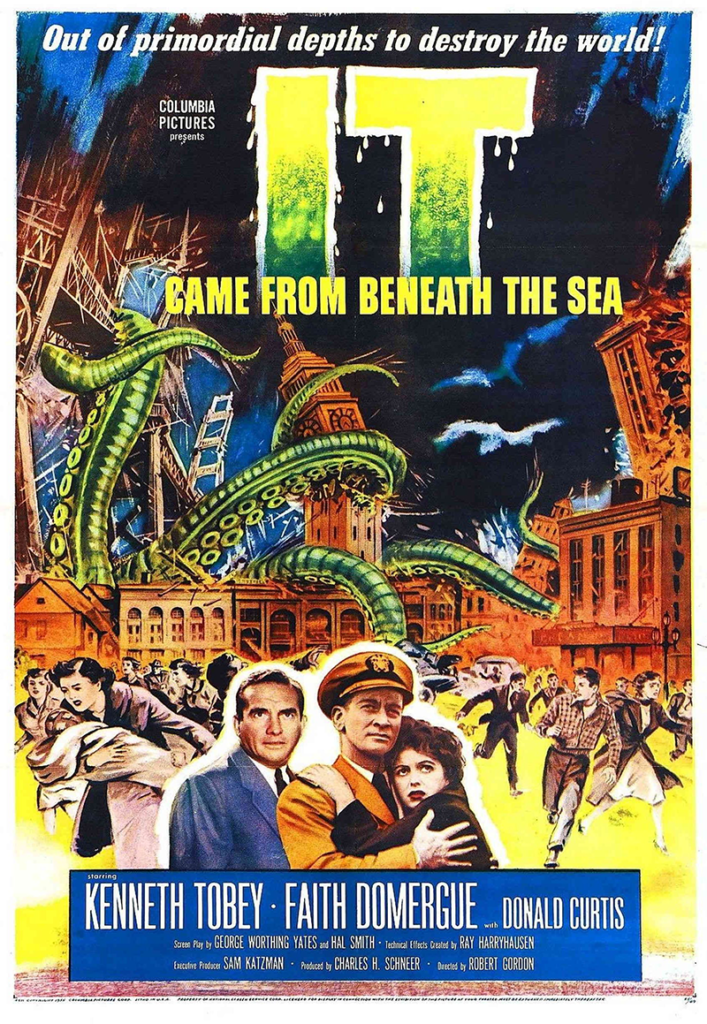Ray Harryhausen is a Hollywood legend. In a time of painstaking manual effects work, his skill as a stop-motion animator was in high demand for those films requiring the fantastical. But, what happened when such a talented worker was called on for a flick with only $150k in its budget?
It Came from Beneath the Sea exemplifies just about everything common in 1950’s b-monster fare. There’s a gigantic monster that was created by American nuclear testing (of course); a square-jawed hero in the form of Commander Pete Mathews of the United States Navy (Kenneth Tobey, making his second appearance in this year’s Horrorshow); a scientist-in-residence who provides useful exposition in Dr. John Carter (Donald Curtis); and a plucky love interest who challenges, but still resides in, 1950s Hollywood sexual mores in Professor Lesley Joyce (Faith Domergue). Add all these ingredients, stir in some scenes of wanton destruction and much fretting in a laboratory, and one has a monster flick. It’s as easy as that.
I don’t wish to denigrate the work of director Robert Gordon too much, but this film does something rather spectacular. In a time when the monster flick was still new, Gordon managed to craft a film that is rote in the extreme. There isn’t a scene in the film that doesn’t feel mechanical. I kept waiting for the film to break out in some way — to provide something lasting to the genre, or at least something that hadn’t been done better already — but there was nothing. Neither inept nor excellent, It Came from Beneath the Sea slips into mediocrity like it’s a quilt on a cold winter’s eve.
The films begins strongly enough. In the opening, Commander Mathews is at sea as the skipper of a brand new nuclear submarine on its shakedown run. Suddenly, sonar picks up a large object closing  on the submarine fast. The sub tries to outrun it, but it grabs the sub and brings it to a sudden halt beneath the waves. The crew manages to free the sub and head back to port, and Commander Mathews is tasked by the navy to find out exactly what attacked his sub.
on the submarine fast. The sub tries to outrun it, but it grabs the sub and brings it to a sudden halt beneath the waves. The crew manages to free the sub and head back to port, and Commander Mathews is tasked by the navy to find out exactly what attacked his sub.
Sharp-eyed viewers will spot that despite the tension in this scene, nothing happens outside the sub. That is, there’s noise and some camera shakes, and steely gazes from the cast, but all we viewers ever see is the bridge of the submarine. This extended opening sequence feels like it was crafted to save money as much as establish tension.
This is confirmed after Mathews returns to land. There, he is joined by Carter and Joyce for a long sequence where they stare through microscopes and go through the motions of a half-hearted Hollywood love triangle. The film almost comes to a dead stop in this act. There’s so much filler that one can taste the sawdust.
The monster does show up on screen eventually. It’s a gigantic octopus. Most of the time we see it, there’s only one or two tentacles on screen. Harryhausen got a lot of mileage out of the largest appendage. It peeks up over the sides of ships or railings on shore and wreaks its havoc. It crushes cars and people alike. It’s covered in suckers that look like the tied-off ends of balloons, or something else should one have a naughty mind. The octopus is used less than the film calls for, which must be down to the budget, but the quality is better than Harryhausen’s work in The Beast from 20,000 Fathoms. Composite shots are much closer in exposure and grain, although they still don’t mesh all that well.
The final act has an iconic monster flick shot here and there, but overall this film is somewhat of a throwaway experience. The script fails to engage and the actors could have all been replaced by a sock puppet repertory. I kept waiting for this film to come alive, and it never did.
